
Lionel Barrymore was an American actor of stage, screen and radio as well as a film director. He won an Academy Award for Best Actor for his performance in A Free Soul (1931) and is known to modern audiences for the role of villainous Mr. Potter in Frank Capra's 1946 film It's a Wonderful Life.

Ethel Barrymore was an American actress and a member of the Barrymore family of actors. Barrymore was a stage, screen and radio actress whose career spanned six decades, and was regarded as "The First Lady of the American Theatre". She received four nominations for the Academy Award for Best Supporting Actress, winning for None but the Lonely Heart (1944).
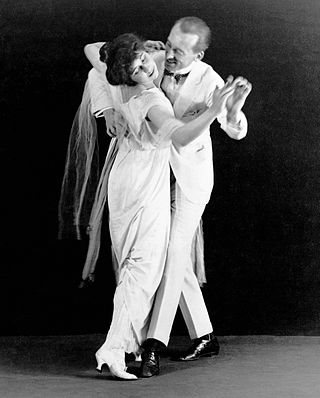
Vernon and Irene Castle were a husband-and-wife team of ballroom dancers and dance teachers who appeared on Broadway and in silent films in the early 20th century. They are credited with reviving the popularity of modern dancing. Castle was a stage name: Vernon was born William Vernon Blyth in England. Irene was born Irene Foote in the United States.

Marguerite Churchill was an American stage and film actress whose career lasted 30 years, from 1922 to 1952. She was John Wayne's first leading lady, in The Big Trail (1930).

Paris is a 1929 American pre-Code musical comedy film, featuring Irène Bordoni. It was filmed with Technicolor sequences: four of the film's ten reels were originally photographed in Technicolor.
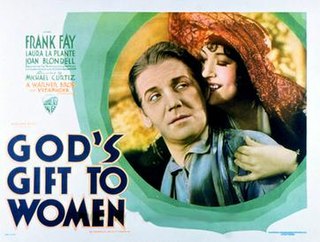
God's Gift to Women is a 1931 American pre-Code romantic musical comedy film directed by Michael Curtiz, starring Frank Fay, Laura LaPlante, and Joan Blondell. The film, based on the play The Devil Was Sick by Jane Hinton, was originally completed as a musical film; however, because of audience dislike for musicals at that time, all the songs were cut in American prints. The full film was released intact in other countries, where there was no such decline in popularity.
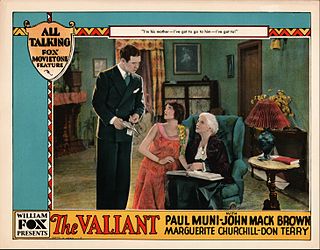
The Valiant is a 1929 American pre-Code drama film released by Fox Film Corporation in the Fox Movietone sound-on-film system on May 19, 1929. It is produced and directed by William K. Howard and stars Paul Muni, Marguerite Churchill, and John Mack Brown. Although described by at least one source as a silent film containing talking sequences, synchronized music, and sound effects, The Valiant has continuous dialogue and is a full "talkie" made without a corresponding silent version.

I Am Suzanne! is a 1933 American pre-Code romance film involving puppeteers in Paris written by Edwin Justus Mayer, directed by Rowland V. Lee, and starring Lilian Harvey, Gene Raymond and Leslie Banks. The picture's puppetry sequences feature the Yale Puppeteers and Podrecca's Piccoli Theater. The Museum of Modern Art in New York City owns and periodically exhibits a 35mm print of the film while the Eastman House in Rochester, New York, archives a 16mm copy.
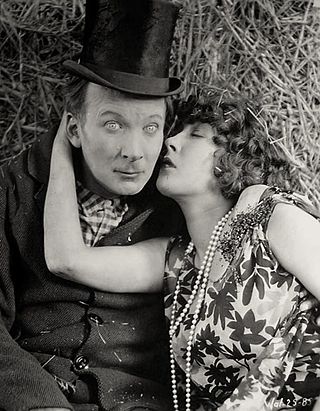
Hot for Paris is a 1929 American pre-Code black-and-white romantic adventure musical film. This film is believed to be lost. The film is also known as Fifì dimmi di sì in Italy and Un marido afortunado in Spain. The film length (metres) is 1710.84 m in the silent version and 2002.54 m in the sound version.

Under the Red Robe is a 1937 British-American historical adventure film directed by Victor Sjöström and starring Conrad Veidt, Annabella and Raymond Massey. Previously filmed as a 1923 silent directed by Alan Crosland. Before the films a play had been produced on Broadway in 1896-97 starring Viola Allen and William Faversham. The film is based on the 1894 novel by Stanley J. Weyman and is set during the religious wars of early 17th century France; events in the novel itself means it can be dated to the autumn of 1630.

So This Is London is a 1930 American pre-Code comedy film directed by John G. Blystone and starring Will Rogers, Irene Rich, Frank Albertson and Lumsden Hare.

Five and Ten is a 1931 American pre-Code romantic drama film directed by an uncredited Robert Z. Leonard and starring Marion Davies, Leslie Howard and Irene Rich. Davies plays as an heiress and Howard the man she loves, though he marries someone else. The film was produced by William Randolph Hearst's Cosmopolitan Productions in partnership with Metro-Goldwyn-Mayer. It is based on the 1929 Fannie Hurst novel of the same name.

The Fortunes of Fifi is a 1917 American silent historical romance film directed by Robert G. Vignola and starring Marguerite Clark. Based on the novel of the same name by Molly Elliot Seawell, the film is set in France and takes place during the era of Napoleon Bonaparte. The film is now presumed lost.
Seven Faces is a 1929 American pre-Code drama film with fantasy elements that was released by Fox Film Corporation in the Fox Movietone sound-on-film system on December 1, 1929. Based upon the piece of short fiction "A Friend of Napoleon" which was published in the June 30, 1923, issue of The Saturday Evening Post magazine by popular writer Richard Connell, it was directed by Berthold Viertel and stars Paul Muni in his second screen appearance. Seven Faces is a lost film, with no excerpts from its footage known to exist.

Charlie Chan Carries On is a 1931 American pre-Code mystery film directed by Hamilton MacFadden and starring Warner Oland, John Garrick and Marguerite Churchill. It is the first appearance of Warner Oland as Charlie Chan. Part of the long-running Charlie Chan series, it was based on the 1930 novel of the same title by Earl Derr Biggers. It is now considered a lost film; however, Fox simultaneously filmed a Spanish-language version which was released under the title Eran Trece—There Were Thirteen—and this version survives.

Virginia Sale was an American character actress whose career spanned six decades, during most of which she played older women, even when she was in her twenties. Over the 46 years she was active as an actress, she worked in films, stage, radio and television. She was famous for her one-woman stage show, Americana Sketches, which she did for more than 1,000 performances during a 15-year span.

Down to Earth is a 1932 American pre-Code comedy film directed by David Butler and starring Will Rogers, Dorothy Jordan and Irene Rich. It is a sequel to the 1929 film They Had to See Paris, with the Peters family returning to America where their wealthy lifestyle is suddenly hit by the Great Depression.
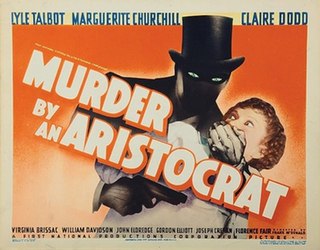
Murder by an Aristocrat is a 1936 American mystery film directed by Frank McDonald and starring Lyle Talbot, Marguerite Churchill and Claire Dodd. The film was based on a 1932 novel of the same title by Mignon G. Eberhart, with sets designed by Hugh Reticker. It was the seventh of 12 B-mysteries released by Warner Bros. as part of their "Clue Club" series between 1935 and 1938.

Behold This Woman is a 1924 American silent drama film directed by J. Stuart Blackton and starring Irene Rich, Marguerite De La Motte and Charles A. Post.

Black and White is a 1931 French comedy film directed by Marc Allégret and Robert Florey and starring Raimu, André Alerme and Louis Baron fils. Described as a "feeble racist comedy" it was the feature screen debut to the comedian Fernandel. It is an adaptation of the 1922 play of the same title by Sacha Guitry, who wrote the screenplay.




















